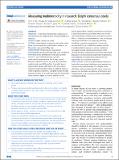Files in this item
Measuring multimorbidity in research : Delphi consensus study
Item metadata
| dc.contributor.author | Ho, Iris S S | |
| dc.contributor.author | Azcoaga-Lorenzo, Amaya | |
| dc.contributor.author | Akbari, Ashley | |
| dc.contributor.author | Davies, Jim | |
| dc.contributor.author | Khunti, Kamlesh | |
| dc.contributor.author | Kadam, Umesh T | |
| dc.contributor.author | Lyons, Ronan A | |
| dc.contributor.author | McCowan, Colin | |
| dc.contributor.author | Mercer, Stewart W | |
| dc.contributor.author | Nirantharakumar, Krishnarajah | |
| dc.contributor.author | Staniszewska, Sophie | |
| dc.contributor.author | Guthrie, Bruce | |
| dc.date.accessioned | 2022-08-10T15:30:29Z | |
| dc.date.available | 2022-08-10T15:30:29Z | |
| dc.date.issued | 2022-07-27 | |
| dc.identifier | 279760116 | |
| dc.identifier | 1261ac95-b6c7-433c-b70d-2b53bc0e7e0d | |
| dc.identifier.citation | Ho , I S S , Azcoaga-Lorenzo , A , Akbari , A , Davies , J , Khunti , K , Kadam , U T , Lyons , R A , McCowan , C , Mercer , S W , Nirantharakumar , K , Staniszewska , S & Guthrie , B 2022 , ' Measuring multimorbidity in research : Delphi consensus study ' , BMJ Medicine , vol. 1 , no. 1 , e000247 . https://doi.org/10.1136/bmjmed-2022-000247 | en |
| dc.identifier.issn | 2754-0413 | |
| dc.identifier.other | RIS: urn:84E8FCFF73B5F025234CB3E0AC0E43B2 | |
| dc.identifier.other | ORCID: /0000-0002-9466-833X/work/116597532 | |
| dc.identifier.other | ORCID: /0000-0003-3307-878X/work/116598377 | |
| dc.identifier.other | RIS: urn:84E8FCFF73B5F025234CB3E0AC0E43B2 | |
| dc.identifier.uri | https://hdl.handle.net/10023/25814 | |
| dc.description.abstract | Objective To develop international consensus on the definition and measurement of multimorbidity in research. Design Delphi consensus study. Setting International consensus; data collected in three online rounds from participants between 30 November 2020 and 18 May 2021. Participants Professionals interested in multimorbidity and people with long term conditions were recruited to professional and public panels. Results 150 professional and 25 public participants completed the first survey round. Response rates for rounds 2/3 were 83%/92% for professionals and 88%/93% in the public panel, respectively. Across both panels, the consensus was that multimorbidity should be defined as two or more long term conditions. Complex multimorbidity was perceived to be a useful concept, but the panels were unable to agree on how to define it. Both panels agreed that conditions should be included in a multimorbidity measure if they were one or more of the following: currently active; permanent in their effects; requiring current treatment, care, or therapy; requiring surveillance; or relapsing-remitting conditions requiring ongoing care. Consensus was reached for 24 conditions to always include in multimorbidity measures, and 35 conditions to usually include unless a good reason not to existed. Simple counts were preferred for estimating prevalence and examining clustering or trajectories, and weighted measures were preferred for risk adjustment and outcome prediction. Conclusions Previous multimorbidity research is limited by inconsistent definitions and approaches to measuring multimorbidity. This Delphi study identifies professional and public panel consensus guidance to facilitate consistency of definition and measurement, and to improve study comparability and reproducibility. | |
| dc.format.extent | 1745901 | |
| dc.language.iso | eng | |
| dc.relation.ispartof | BMJ Medicine | en |
| dc.subject | RA Public aspects of medicine | en |
| dc.subject | NDAS | en |
| dc.subject.lcc | RA | en |
| dc.title | Measuring multimorbidity in research : Delphi consensus study | en |
| dc.type | Journal article | en |
| dc.contributor.institution | University of St Andrews. School of Medicine | en |
| dc.contributor.institution | University of St Andrews. Sir James Mackenzie Institute for Early Diagnosis | en |
| dc.contributor.institution | University of St Andrews. Population and Behavioural Science Division | en |
| dc.identifier.doi | https://doi.org/10.1136/bmjmed-2022-000247 | |
| dc.description.status | Peer reviewed | en |
This item appears in the following Collection(s)
Items in the St Andrews Research Repository are protected by copyright, with all rights reserved, unless otherwise indicated.

